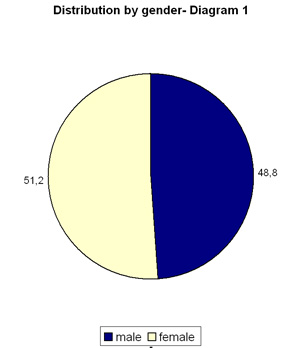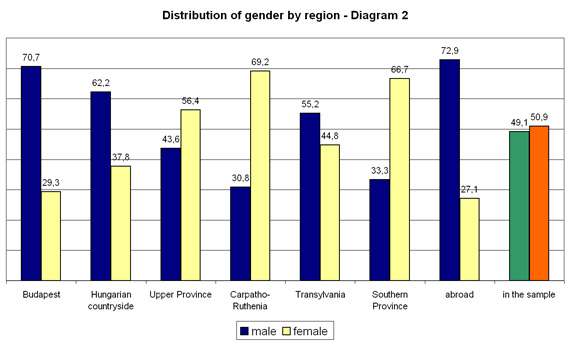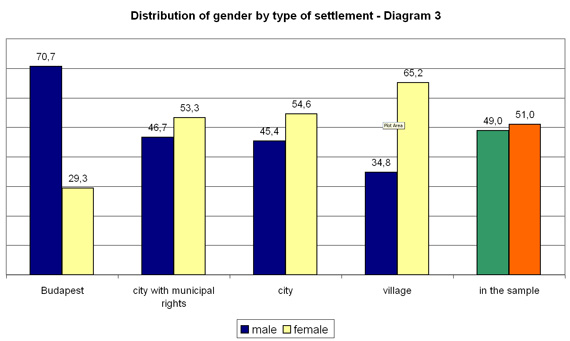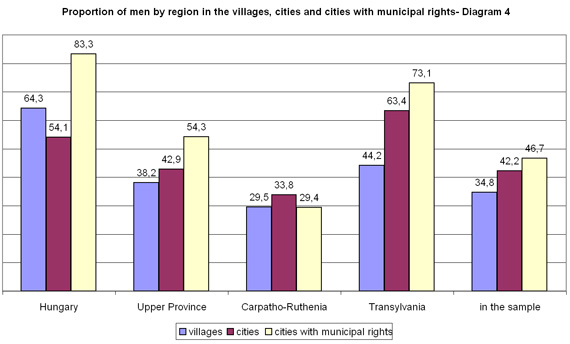Distribution of Gender of the DEGOB Survivors
As diagram 1 shows, the proportion of men and women in the DEGOB protocols is almost equal. This is in compliance with the data of the 1941 census, according to which men constitute 49 percent of the total population (Jews and Gentiles together), while the proportion of women is 51 percent. In the case of the Jewish population-which registered as of the Israelite religion-these proportions were as follows: 47.8 percent male, 52.2 percent female. Thus in the protocols, the proportion of the men is a percent higher than in the census, and consequently that of the women is a percent lower.

In the following paragraphs, we examine the proportion of gender by regions.
Distribution of gender by type of settlement
Proportion of gender in the different regions by type of settlement
Distribution of gender by region

Significant differences might be observed in diagram 2: while the majority of the survivors from Trianon Hungary[1] are men (and this is the same in the case of Transylvania, though in a smaller scale), the situation is precisely the opposite in the other dominant region of the sample, Carpatho-Ruthenia.[2] Here we find mainly women, 69.2 percent of the DEGOB survivors from this region are female. Though on a smaller scale, the women are the majority in the case of the Upper Province, too.
In the DEGOB collection, there are only three persons from the Southern Province (a territory that was re-annexed from Yugoslavia in 1941), therefore we can not evaluate the data of this region. Based on our data we might conclude that in the sample-with the significant exception of Transylvania-the majority of those from the re-annexed territories are women.
Distribution of gender by type of settlement
We might point out a similar attribute if we examine the proportion of gender by type of settlement.

Diagram 3 clearly indicates the dominance of men in the capital, while in the other settlements-especially in the villages-the prevalence of women is apparent. Based on the examination of the whole sample we can assert that the DEGOB survivors from Budapest are predominantly men, while those coming from other settlements are mainly women.
Proportion of gender in the different regions by type of settlement

This diagram shows the proportion of men in the different regions by type of settlement. As we have seen in diagram 2 the proportion of gender in the sample is varied by regions. However, since different types of settlements are typical of different regions, it is feasible that the variance observed in the gender distribution is in fact caused by the variance of the types of settlements. In other words, it is conceivable that the correlation is not between the gender and the regions, rather the gender and the type of settlement or the region and the type of settlement. The correlation between the gender distribution and the region is further specified by the type of settlement as follows: "Southern Province" and "abroad" have been left out of the regions due to their small number of cases, and we fused "Budapest" and the "Hungarian countryside" into the region "Hungary".[3]
In the complete sample, it is well observable that heading down on the "settlement slope" the correlation between the region and the gender distribution is decreasing: in the cities with municipal rights the proportion of men in the various regions largely differs; in the villages the difference is significant, though regionally smaller than in the case of the cities with municipal rights. Consequently the correlation between the region and gender remains when controlled for type of settlement; it is especially significant in the case of the cities with municipal rights.
Footnotes
[1] In the diagram, Budapest (proportion of men is 70.7 percent) and the Hungarian countryside (proportion of men is 62.2 percent) constitute "Trianon Hungary" together.
[2] See diagram 1 of the "Region" menu point.
[3] It would be more precise to call this region "Trianon Hungary", since the fusion of the two regions covers this territory, but to simplify the category system we use the term "Hungary".

